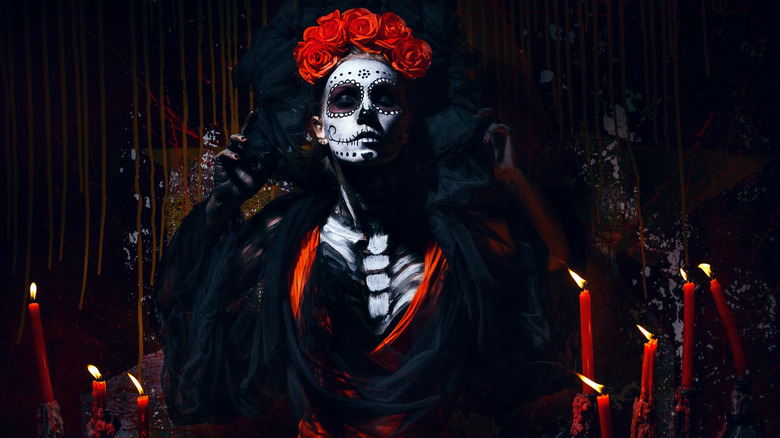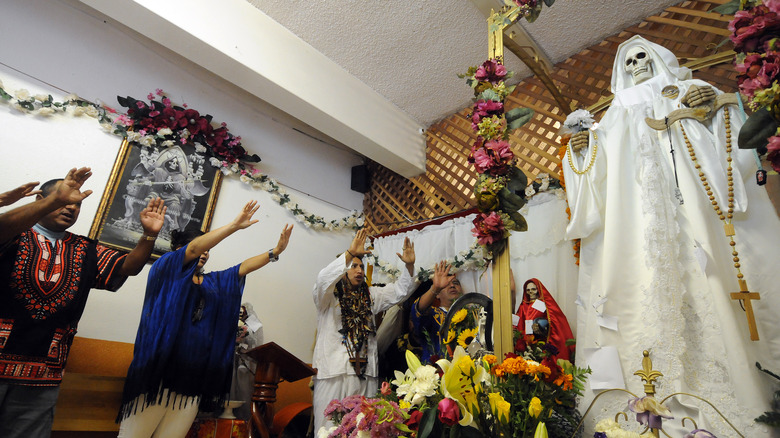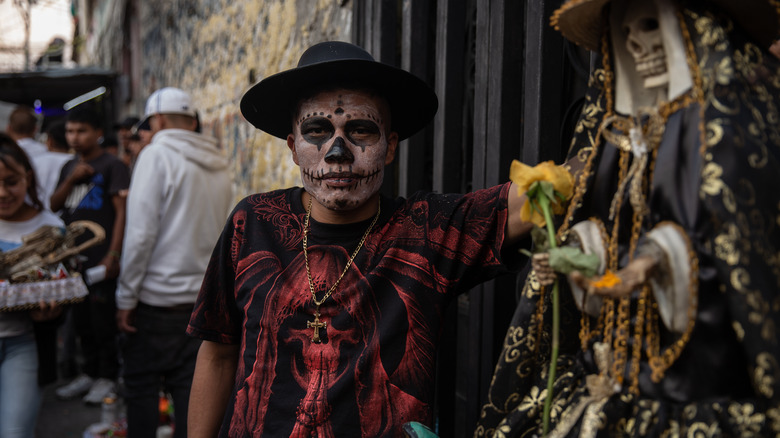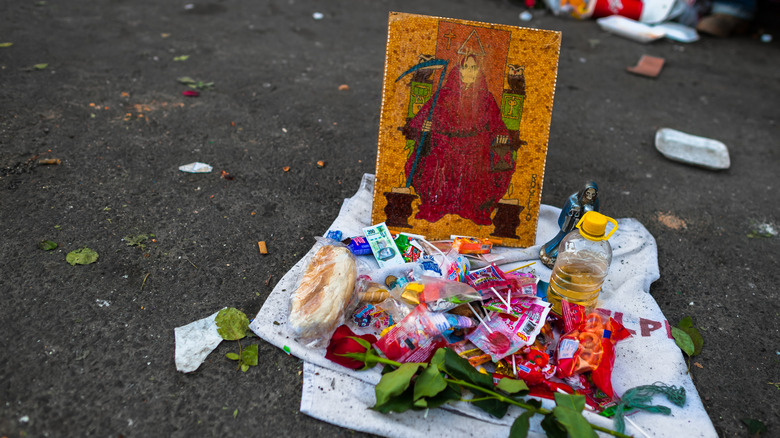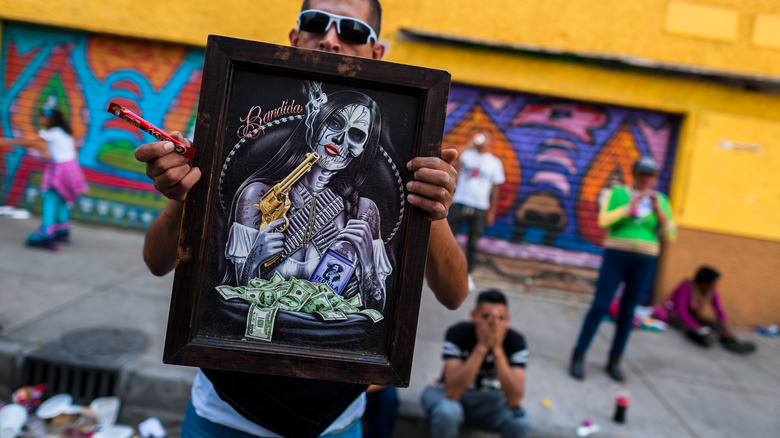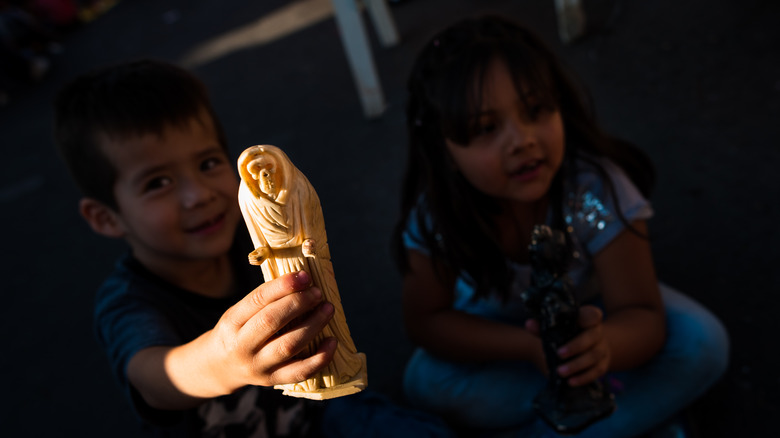Who Is Santa Muerte, The Mexican-Catholic Folklore Goddess Of Death?
So we're all familiar with that spooky, skeletal Día de los Muertos (Day of the Dead) face makeup, right? White foundation, black lines across the lips, flower patterns around the eyes, and so forth? Throw some scarves in there, veils, bouquets, etc., and you've got a legit costume not just for Mexico's Día de los Muertos, but Halloween or any other happy-go-lucky, jolly event. But do take care the next time you're thinking of buying a DIY stencil kit to beautify your face with skeletal imagery. That portrait — the skeletal, feminine face of death — belongs to a rapidly growing Mexican faith that's ballooned far beyond it's original, folklore-ish origins into a full-blown, Catholic-adjacent, indigenous belief-fueled religion with its own rituals, ceremonies, shrines, holy days, and a central goddess of death at the center of it all: Santa Muerte.
In case you missed out on Spanish class or sidestepped its basic vocabulary, Santa Muerte means exactly what it says: Holy Death. During the latter half of the 20th century belief in Santa Muerte spread from its focal point in the Mexican drug cartel-operated barrio of Mexico City, Tepito, described by journalist Antonio Nieto in Vice as a place of killings, sicarios (hitmen), drugs, and overall "extreme violence." The Collector says that the nascent religion — if indeed it can be classified as such — has spread throughout the Spanish-speaking world in Central and South America, the Philippines, Europe, and more. Now, Andrew Chesnut, author of "Devoted to Death: Santa Muerte," says Santa Muerte has 10 to 12 million followers worldwide (per the BBC).
Aztec death god meets Catholic devotionals
In a modern, recorded sense, we can pinpoint the first printed mention of Santa Muerte to the 1961 Oscar Lewis novel "Los hijos de Sánchez," as The Daily Chela explains. She's mentioned in conversation between two characters as a commonplace figure in Mexican life, albeit a hush-hush, occult one "passed by word of mouth," particularly between women. Within the plot of the book, Santa Muerte is invoked in a ritual novena — stock Catholic prayers for standardized purposes — at noon to help "rehabilitate" wayward husbands. Lewis, an anthropologist, didn't make Santa Muerte up. He used what had already taken root in Mexico City's Tepito neighborhood since at least the mid-1950s.
However, beliefs and practices like those involving Santa Muerte don't sprout up overnight, or even over a mere decade. The Collector says that Spaniards during the Spanish Inquisition (1478 to 1834) tried their darndest to stamp out native practices of "making offerings to skeletal images" as late as the 1790s. Mesoamerican cultures were a bit preoccupied with brutal practices like human sacrifice, especially the Aztecs in modern-day Mexico. And indeed, the Aztec death god Mictlantecuhtli, who presided over the land of the dead with his wife Mictecacíhuatl, had a skull face just like Santa Muerte. It stands to reason that indigenous Aztec practices continued in evermore secretive ways during the Spanish Inquisition, got transmitted through generations, and in the case of Santa Muerte, took influence from Roman Catholicism.
Protector of the marginalized
So if followers of a religion like Catholicism go to mass, partake in Communion, undergo confession, etc., what do believers in Santa Muerte do? According to a 2017 BBC article, they basically do the same thing despite all the gothic-horror skull imagery and having a reputation for being "a death cult for criminals and drug traffickers." There's a cross-wearing priest — Daniel Santana, in the BBC-described case — who officiates a set of hymns, prayers, and readings at an honest-to-goodness Santa Muerte temple. Folks bring offerings to Santa Muerte — aka the Bony Lady — including flowers, tequila, beer, snacks, sweets, chocolate, and cigarettes, sometimes stuck in her statue's skeletal mouth to burn. In return, they ask for favors for anything and everything.
One mother-to-be, Isabel, asked Santana for Santa Muerte's blessing. She's been a "devotee" since childhood, same as the middle-aged Santana himself. "I had complications with my pregnancy," she said, "but I prayed to her and now everything is fine." She travels an hour every month to Santa Muerte's temple for devotional purposes. Others laud Santa Muerte's "non-judgmental nature," which is doubtlessly why she's come into favor amongst outcasts, drug users, the disabled, the homeless, the unemployed, and more.
Speaking of Santa Muerte worship in general, Santana said, "It's a widely misunderstood faith. It's not a satanic Mass. ... She gives people what they want and when they finish their cycle of life here on earth she comes for their souls," adding, "She's just fulfilling God's orders."
Decried by the Vatican
It might not be surprising to folks, but the Catholic Church hasn't taken too kindly to Santa Muerte, especially now that Santa Muerte rituals and beliefs have emerged into the mainstream. The BBC says that the Vatican in 2013 declared Santa Muerte "blasphemous." Cardinal Gianfranco Ravasi, president of the Vatican's Pontifical Council for Culture, described Santa Muerte worship as a "degeneration of religion." This isn't the only time the Catholic Church has taken this position, which might not do much for the Santa Muerte followers who prefer their goddess' aforementioned "non-judgment nature." It bears noting that the 2013 BBC article and another 2012 BBC article both refer to Santa Muerte worship as a "cult." The previously cited, later 2017 article featuring Daniel Santana and the mother-to-be Isabel, however, uses the word "religion."
This subtle, but critical, shift in tenor illustrates how Santa Muerte's popularity has surpassed any attempts to control the faith's growth or shame its followers. In fact, per The Collector, many of those followers still by and large consider themselves Catholic. To them, they've just added an additional figure to their pantheon whom they consider more approachable. Santa Muerte is a saint, as The Collector aptly puts it, for those who've "lost faith that existing institutions will speak to their everyday struggles." This is troubling to the Catholic Church, which has lost ground in Mexico not only to Santa Muerte — who is all but universally known in the country at this point — but to Mexican Protestantism, as Pew Research Center data shows.
Beloved by cartels
On the BBC, Cardinal Gianfranco Ravasi decries Santa Muerte worship not just for being blasphemous, but because Santa Muerte is well-regarded amongst Mexican gangsters. It's no secret that patches of Mexico have all but fallen to drug cartels — it's even been dramatized in TV shows like "Narcos" and movies like "Sicario." Global Guardian describes Mexico as caught between two major cartels above the rest: The old guard Sinaloa Cartel (CDS) and younger expansionist Cartel Jalisco Nueva Generacion (CJNG). Violence continues to escalate, and more and more people are killed or vanish every year. Global Conflict Tracker says that in 2018 there were over 33,000 drug-related killings in Mexico, while in 2019 Crisis24 reported over 60,000 people have gone missing in connection with cartels.
It's true that gangsters — like those in the Tepito, Mexico City-based regional cartel La Unión Tepito — make no secret of their love of Santa Muerte. Tepito is a Santa Muerte hotspot, and has altars so prominent that they're publicly discussed on sites like Trip Advisor and labelled as a "Place[s] of worship" on Google Maps. There's even an Instagram page featuring some very obvious Unión Tepito cartel members sporting Santa Muerte tattoos and statues. But of course, criminals can be just as religious as the next person, and no causal relationship has been found between Santa Muerte worship and cartel violence.
A holy, commodified death
As The Daily Chela points out, Mexico's cartel-driven sociopolitical instability only strengthens the desires of the disillusioned, disenchanted, and marginalized to cling to a spiritual figure that actually "gets" them. Santa Muerte — Holy Death — may indeed be the most that some in Mexico and elsewhere can hope for; for the terrified, she makes death less terrifying. Along those lines, The Collector points out that Santa Muerte is perfectly situated as a go-to entity for those who want to "find solace in an abstract folk healer saint who doesn't play favorites with believers."
And yet, Santa Muerte has already become commodified. Factories in places like Mexico and China churn out Santa Muerte statues and other goods, which sell on Mexican streets to locals and tourists alike. A quick search online reveals gobs of Santa Muerte products, from low-end kitsch on Amazon to upscale Etsy marketplace goods. We're talking candles, phone cases, figurines, rosaries, rings, whiskey flasks, pendants, fragrant air sprays, and much more.
The Washington Post describes a "Salvadoran seamstress" in Los Angeles who makes $1,000 dresses for large Santa Muerte statues. Cristina Perez, owner of "folk-medicine and esoteric store" Botica El Angel in Richmond, Virginia, says that Santa Muerte "makes up half of my sales." She prays to the Santa Muerte statue in her shop every morning, invoking "the name of the Father and the Holy Spirit" for "abundance, work, health, and family unity."
